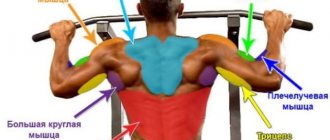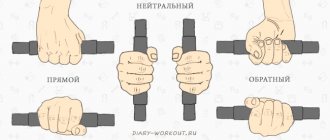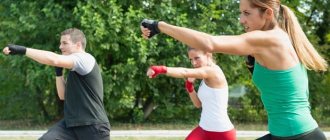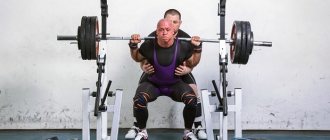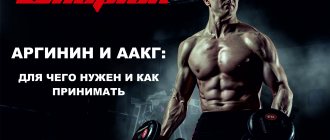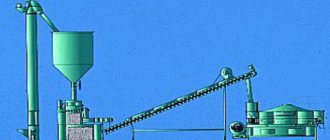Author: Timko Ilya - the ruler of the entire site and fitness trainer | more details >> Rod. 1984 Trained since 1999 Trained since 2007. Author and creator of the site tvoytrener.com. CCM in powerlifting. Champion of Russia and South Russia according to AWPC. Champion of the Krasnodar region according to IPF. 1st category in weightlifting. 2-time winner of the Krasnodar Territory championship in t/a. Author of more than 700 articles on fitness and amateur athletics. Author and co-author of 5 books.
Place in the author rating:
out of competition
(become an author)
Date:
2016-08-14
Views:
19,941
| All articles by the author >> | Medals articles >> |
Articles are loading...
Main muscles - latissimus Additional - biceps, rear delta, teres major and rhomboids Difficulty - high
Now let's talk about pull-ups. But not about strength, but about building up. Kipping and butterfly pull-ups have become very popular thanks to the spread of CrossFit. The fact is that, according to the rules of CrossFit, you need to do pull-ups so that at the top point your chin is higher than the bar, and at the bottom point your arms are straight at the elbows. That's all. Not a word about the buildup. Therefore, kipping and butterfly have taken root well, as they allow you to save energy and time on pull-ups due to the inertia of the body. Let's talk below about these two types of pull-ups.
What are kipping pull-ups?
Kipping pull-ups are a type of pull-up in which your hips and legs swing and use momentum to help you pull yourself up. This significantly reduces the load on your hands.
There is also an advanced version called the butterfly pull-up, which uses constant motion to produce even faster pull-ups. In this case, a larger array of muscles and movement impulse are used to move the body in space.
For competitive CrossFitters, kipping helps them get more reps in less time. This does not violate the rules of their sport in any way, so for them it is quite an exercise. Well, for guys who want to gain more “meat” and increase strength, should they do this exercise? Is it safe? And most importantly, do you need to learn how to do it?
Execution technique
- Grasp the bar with an overhand grip at a distance slightly wider than shoulder-width apart. Important! During the exercise, the legs should be extended and connected together. The body is tense. This will ensure maximum swing amplitude.
- We perform pull-ups: in the upper position, the chin is above the crossbar, and in the lower position, full straightening in the elbow joints.
- We slightly round our chest and bring our legs back.
- We perform a powerful movement forward and upside down with our legs and pelvis, while our torso and shoulders go back and return in an arc to the crossbar.
- We bring our chest under the bar and prepare the next swing without pausing.
- Unlike kipping, without hanging in the upper position, we fly under the crossbar.
We recommend watching a video on the technique of teaching butterfly pull-ups:
Kipping and pressing "shvung"
Kipping is related to a strict pull-up in the same way that a push press is related to a “military” press.
In both the kipping and push press, you use the momentum created by the lower body to assist the movement of the upper body. That is, the stronger the impulse you give with your lower body, the easier it will be for your upper body. And it will be easier to lift more weight or do more repetitions.
So is the shwung press a cheating or a type of bench press? One thing I am sure of is that in both cases, the person performing these exercises will either look super athletic, focused and powerful, or they will look like they are having a seizure.
I really like the high snatch, which is very similar to the kipping pull-up: you use your lower body to create as much momentum as possible so you don't have to strain your arms as much. Am I cheating too?
Kipping is not cheating
A true kipping pull-up is not just a cheat pull-up. This is a fairly complex technical movement. The correct kipping technique requires the athlete to have endurance, strength and coordination. Especially when performing several pull-ups in a row (that is, without a pause in the bottom position between repetitions), and all these qualities are needed even more when performing the butterfly.
The same can be said about the press “shvung”. This is not just a “military” bench press with cheating. A very precise movement that requires a certain body position and good endurance. You need to use your hands at the right moment - not earlier, not later.
Few people criticize the push-up press; so far, kipping pull-ups receive more angry letters. And it's strange. In both cases, you do one thing - use momentum to help your upper body complete the rep.
When we talk about these exercises, we're talking about compound movements. In two cases, those who do them incorrectly will appear epileptic and increase the risk of injury. But if both pull-ups are done correctly, then they are safe.
Maybe it’s because kipping was popularized by crossfitters, and the push press by weightlifters? It seems to me that now every hardcore poser feels obligated to hate CrossFitters. Although for me there is no difference. Anyway, I'm not saying that CrossFit kipping pull-ups are a good exercise and everyone should do them. Also, I’m not saying that the push press can and should be done by everyone without exception.
https://youtu.be/EIndIV0DBPM
History of the bale
Kipping pull-ups were designed to achieve the required number of unbroken reps faster than an athlete who would do strict pull-ups. In fact, people in gyms have been doing them for quite a long time, but they were not called kipping, but simply pull-ups with a slight rocking of the pelvis.
When CrossFit competitions began, the rules for pull-ups stated that the athlete must somehow get his chin over the bar. Coming out of this, cheating pull-ups were allowed. And athletes who manipulated the rules to achieve maximum advantage developed the more complex kipping pull-ups we see today.
Nowadays, you will rarely see an athlete at a CrossFit competition who chooses to do “strict” pull-ups, especially if the routine does not indicate this. At first, kipping pull-ups didn't bother anyone, since they were only performed by top-level athletes who can do a ton of strict pull-ups. Kipping simply helped them finish their WOD faster.
They were made by athletes who had well-developed muscles around the shoulder joint. These muscles could absorb the pressure created by performing kip pull-ups.
Problems appeared when CrossFit went mainstream. Very often, beginners do not have the muscle corset and shoulder mobility to perform kipping pull-ups safely. But what caused the real problems was that even those who were quite weak (individuals who could not do one or two strict pull-ups) could do kipping pull-ups once they learned proper pelvic movement.
But even if you can do it, doesn't mean you should!
Let's go back to the comparison with the push press. If someone is weak and can't hold a 30kg barbell over their head without looking like they're lifting in an earthquake, then they probably shouldn't be allowed to do push presses.
Of course he will be able to lift the barbell over the head thanks to the push of the legs, but the possibility of injury will be high due to the catastrophe that can occur in trying to hold the barbell. Likewise, a person who cannot do strict pull-ups will do kipping.
Problems of horizontal bar lovers
Pull-ups are a rather traumatic thing, especially if you haven’t done anything before. Beginners should choose rubber-coated platforms, or horizontal bars that are dug directly into the sandbox, so as not to be injured if they fall. And it is quite real, especially if there are problems with the grip and exorbitant ambitions that do not allow a person to stop training in time.
In addition, the practitioner should always have magnesium on hand to prevent slipping, calluses and damage to the skin.
Injuries
The main way to prevent injury is to normalize your relationship with your own ego. Stop trying to force jump jumps if you don't know how to do a pull-up yet. Do not perform exercises using the force of inertia if you do not yet have enough muscle strength. Try to do everything technically and complete tasks gradually.
Well, here are the classic recommendations - first warm up by lightly running around the site, then by rotating in all the main joints, after that by pulling the rubber to your chest with the shock absorber secured on top.
Calluses
The reason for their occurrence is not excessive work, or even sweaty palms. Usually, calluses plague those who really like to hang on their fingers, and even swing at the same time. From the very first training, learn to make a palm grip so that the body does not sway from side to side and does not perform pendulum movements. This will help get rid of callus problems. If your training volume is high and you are using weights, feel free to use straps. A good grip is great, but regular training without pain and calluses is even better.
In general, some “roughness” of the palms is the norm, and it only helps to stay on the horizontal bar.
Ligament pain
Here it is necessary to distinguish between inflammation of the ligaments and joints, which are dangerous to health, and muscle soreness. Soreness is a normal practice, and it cannot harm your training in any way. On the contrary, you should actively warm up on days that are not heavy training.
But if the ligaments and joints hurt at night, become inflamed, or seem to “tug” when you are at rest, it is better to consult a doctor to rule out health problems.
Falls from the horizontal bar
This is also normal practice; you need to learn to jump softly and onto the surface. But in fact, most often those who do not use magnesium and who have a weak grip fall from horizontal bars. The second category of athletes must simply develop their grip. If the metal of the crossbar is smooth and slippery, it is worth wrapping a medical plaster around the crossbar to ensure normal adhesion to the coating.
First the “strict” ones!
You shouldn't do kipping until you can do a decent number of strict, full-range pull-ups, starting from a sticking point at the bottom and ending with a slight pause at the top. How much is “decent amount”? At least five. Doesn't sound "decent" enough? Try it first. Start with a hang, then pull yourself up without any inertia, place your chin over the bar, hold for 2 seconds. Then lower yourself back under control into a hanging position and repeat 4 more times.
It's a lot harder than it looks.
It is not enough to just pull yourself up; you must control your body at all stages of the movement - both in lifting and in lowering. If you can't do that, then you can't do kipping.
Similar exercises
You should not start learning the butterfly technique without mastering 2 basic hangs on the bar:
- boat hang
- backbend hang
boat
The sequence of actions is as follows:
- Hang from the bar. Feet don't touch the ground
- Use any comfortable grip
- Bring your straight, tense legs forward at an angle of 10-15 degrees. Keep your abs tight
- Hold this position for 10-15 seconds
- Return to the starting position. Repeat 3-5 times.
Backbend hang
Sequencing:
- Hang from the bar. Feet don't touch the ground. Any grip.
- Bend at the waist. Take your straight, tense legs back.
- Keep your buttocks and thighs tight.
- Hold for 10-15 seconds then return to the starting hang.
- Repeat 3-5 times
Found an error in the article? Select it with the mouse and press Ctrl Enter. And we will fix it!
When and how to start doing kipping pull-ups?
I am not an expert in kipping and do not pretend to be one. Although I know everything about the human body, namely how to train it to reduce the risk of injury.
If you're a CrossFit athlete, you'll likely need to learn how to do kipping pull-ups to improve your performance. And I hope your trainer is competent enough to teach you the correct technique when the time comes. But when will this “time” come?
First you need to go through a few steps
1. You should be able to do 5 strict pull-ups - hanging position, chin over the bar, pause at the top, controlled lowering. Once you can perform several of these approaches, you can begin to learn and incorporate kipping pull-ups into your training; 2. Learn to do kipping with minimal pressure. Pause between reps, or do two, and then from the top position slowly, under control, lower yourself to a hanging position. Don't try to string together repetitions. Focus on performing each repetition correctly and lowering under control. Lowering slowly will help you build the necessary muscle core and develop movement patterns for further safe performance of the kip. You must confidently perform the approaches: precise movements, chin over the bar, pause for 1-2 seconds at the top, controlled lowering. 7-10 reps is your minimum before moving on to the next step; 3. Do strict and kipping pull-ups mixed together. First, do a set of strict pull-ups and when you no longer have any strength left, then start “boiling.” But at the same time, stay at the top and slowly lower down. When you can get 15-20 repetitions in such a combination (7 strict and 8 kip, for example), then you are ready for the next step; 4. Learn to chain pull-ups. Once you feel more confident, try to increase your speed; 5. Learn to do butterfly pull-ups. Please note that this technique is not for everyone. Some competitive CrossFitters have chosen kipping pull-ups for themselves and use them in competitions.
The longer you hold each step, the safer high-intensity kipping pull-ups will be for you.
Does kipping build muscle?
CrossFitters often become overly concerned with their unique exercises. If you tell a CrossFitter that one of their variations is not the best way to build muscle, they will take it personally. But if you tell a weightlifter that the push and jerk is not the best way to build muscle in the shoulders, he will agree with you 100%.
Noting that this exercise is not the best for gaining mass does not mean that it is bad. Try to be objective.
For those involved in competitive CrossFit, the importance of kipping pull-ups is obvious. They help you do more reps without stopping, faster, with much less upper body fatigue.
If you perform the kip correctly, namely with the help of a powerful upward push with your hips, creating momentum, then the load on the upper body will be reduced to a minimum. This type of pull-up is good for getting a lot of reps in a short period of time. But it won't suit you if you want to strengthen your upper shoulder girdle.
The kip also works well on the lats because you're doing a similar movement to a horizontal hang as you push through your hips. And if you lower yourself under control, your arms and back will be tense during the negative phase.
But to be completely honest, the value of kipping for hypertrophy is much less than that of the same strict pull-ups.
I see the point in doing kipping only when you've reached failure on strict pull-ups and want to do a couple more reps.
For example, you're doing strict pull-ups, after eight reps you feel like you can't do another strict pull-up, but if you know how to do kipping correctly, you can do a couple more. And if you lower yourself slowly after each kip, they will definitely trigger better muscle growth. It's like your partner will help you lift the barbell on the bench press a couple more times so that you can do a couple more reps when you go to failure.
So, it turns out that for athletes who want to get bigger, kipping pull-ups are a good way to complete a pull-up set, just like forced reps, negatives, or drop sets.
And if it comes to hatred and controversy, then we should remember the proverb: “Let the one who has never swung on the last sets of crunches throw the first stone.”
Types of grips
Straight grip. The most difficult, because the maximum load falls on the latissimus dorsi muscles. The wider the grip, the less help they receive from other muscle groups. Reverse grip. The main load falls on the arms, and much less on the back. The biceps are worked most effectively. It is recommended to place your hands shoulder-width apart. Different grip (neutral). This is the strongest hand placement. Distributes the load across a large number of muscle groups. It can be used at the very beginning, when you are just starting to gain strength, and sometimes for the last approach (drop set), when your arms are very tired.
About butterfly
Butterfly is an evolved version of kipping. Remember that you need to get your chin over the bar, no matter how. Chris Speller was the first CrossFitter to use the butterfly pull-up in competition, and it has since become a staple for competitive CrossFitters.
They were created to allow you to complete more repetitions in less time. With kipping pull-ups at the top and bottom you slow down and get a second of rest. In butterfly pull-ups, you are constantly in motion. So if you can do them correctly, the butterfly will be much faster than the kip.
But not everyone is cut out for butterfly pull-ups: you have to have very strong shoulders and people with shorter arms have an advantage. Also, such pull-ups require more endurance and a sense of rhythm than kip, so athletes who have previously done gymnastics usually cope with them with an A.
The possible negative impact on the shoulder joint of the butterfly stroke is greater than that of a regular kip. Only very strong athletes with good shoulder flexibility should practice them.
This is why you see top athletes still doing kipping instead of butterfly, even though the latter is much more effective in theory. There is also a high risk of getting a “no rap” when performing the butterfly, due to the fact that you will often have to raise your chin when approaching the bar.
The butterfly stroke also works the deltoid muscles a little and can trigger their growth. But butterfly is a complex movement. And you will have to spend a lot of time and effort if your goal is only to build muscle!
Conclusions:
1. Kipping pull-ups are not the most effective way to build muscle. But it is a necessary skill to master if you want to compete in CrossFit; 2. If an athlete performing kipping pull-ups has well-developed muscles of the shoulder girdle, as well as flexibility of the latter, then this exercise is quite safe for him, or as safe as other ballistic movements such as “Olympic movements” and jumps; 3. Kipping pull-ups can be used to build muscle mass when used as an intensification of a set in which you were doing strict pull-ups, i.e. use them as forced reps or negatives at the end of a set. This should only be attempted by advanced athletes who can perform a large number of strict pull-ups and those who have mastered proper kip technique; 4. Butterfly is used in competitions because this style is faster than regular kipping. This is a very difficult movement that should not be mastered unless you are an advanced CrossFit athlete. The butterfly puts a lot of stress on the shoulders and should only be performed by athletes with a well-developed shoulder girdle and flexibility of the shoulder joint. Butterfly is the most traumatic variation of pull-ups; 5. If for some reason you want to learn how to do kipping pull-ups, you should first build up your strength by doing strict pull-ups. This will help make your shoulders stronger and also more resistant to injury.
https://youtu.be/34hC-PtxXlQ


